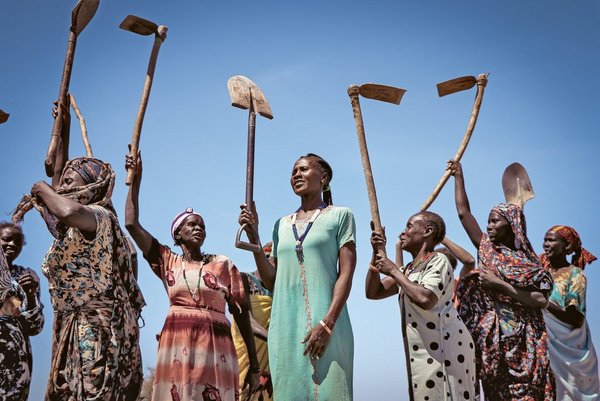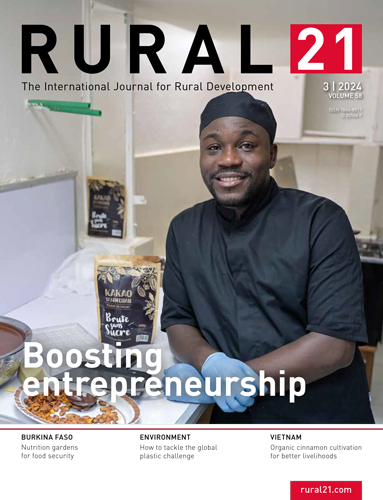- Share this article
- Subscribe to our newsletter
Global Hunger Index 2024 – prospects of reaching zero hunger are grim
In all, 733 million people world-wide have insufficient access to calories, while 2.8 billion people cannot afford a healthy diet. Hunger has been stagnating in 20 countries since 2016, whereas it has even become worse in a further 22 countries. If this trend continues, 64 countries will not reach the low hunger target by 2030. This is the result that the Global Hunger Index (GHI), which Welthungerhilfe now presented for the 19th time on the occasion of World Food Day – the 16th September – together with Concern Worldwide. This year, the report was compiled in cooperation with the Institute for International Law of Peace and Armed Conflict (Institut für Friedenssicherungsrecht und Humanitäres Völkerrecht, IFHV) at Ruhr-Universität Bochum, Germany, for the first time.
Much reason for concern, but some rays of hope
Once again, the world regions with the highest rates of hunger are sub-Saharan Africa and South Asia. Here, the hunger situation corresponds to the category serious – despite both regions having scored considerable success in the period from 2000 to 2016. Six countries – Chad, Madagascar, Yemen, Burundi, Somalia and South Sudan – have alarming levels of hunger, and a further 34 have serious levels of hunger.
Despite all the crises, there are still some success stories. Mozambique and Nepal, for example, have improved their index score by around 30 per cent since 2016. Moreover, some other countries have achieved significant reductions in their scores, including Bangladesh, Mongolia and Togo. And even Somalia, in the face of significant issues, has made some progress in the same period.
Cuts in development budget “highly problematic”
Such success stories cannot, however, disguise the fact that, given the present development, a low level of hunger at global level would only be reached by 2160, i.e. in more than 130 years. “I cannot accept such development,” commented Welthungerhilfe President Marlehn Thieme, stressing that the reasons for hunger are just as clear as the solutions. Despite this, the member countries of the Organisation for Economic Co-operation and Development (OECD) made a mere 0.37 per cent of their Gross Domestic Product available to Official Development Assistance in 2023, which is far less than the internationally agreed goal of 0.7 per cent. “We view the disproportionately high cuts reducing humanitarian aid and structural transitional aid to a level that is even lower than it was in times before Corona as highly problematic,” said Thieme, criticising present developments in the Federal Budget.
Investing in gender justice
The focus in this year’s GHI report is on the link between a lack of gender justice, food security and the impact of climate change. World-wide, one billion girls were suffering malnutrition, said Welthungerhilfe General Secretary Mathias Mogge, pointing out women were particularly hard hit by the consequences of climate change. In droughts, they had to go farther to fetch water or gather fuelwood, they were left behind when the men had to migrate because of crises, and they were particularly affected by social welfare programmes being abandoned because of a lack of finance in times of crisis.
“Gender justice is an important lever to sustainably eliminate hunger. Governments have to invest in health, education and rural development in order to get rid of existing inequality and enable women to gain better access to decisions and resources,” Mogge demanded. One positive example he referred to is Bangladesh, where the government has declared food security a priority and investing in education and promoting gender justice has paid its way. And then there is Liberia, whose President has honoured his commitment to implement the right to food. In this country, legislation has now been reformed to give women access to land as well.
Measuring hunger
The Global Hunger Index (GHI) categorises and ranks countries on a 100-point scale and breaks their hunger situation down into five categories: low, moderate, serious, alarming and extremely alarming.
GHI scores are based on a formula that captures three dimensions of hunger – insufficient caloric intake (undernourishment), child undernutrition, and child mortality – using four component indicators:
- Undernourishment: the share of the population that is undernourished, reflecting insufficient caloric intake
- Child wasting: the share of children under the age of five who are wasted (low weight-for-height), reflecting acute undernutrition
- Child stunting: the share of children under the age of five who are stunted (low height-for-age), reflecting chronic under-nutrition;
- Child mortality: the mortality rate of children under the age of five.
Data from various UN and other multilateral organisations for 136 countries was evaluated for the GHI 2023. The data originates from the years 2019 to 2023. Acute crises such as the one in the Gaza Strip are not reflected in the GHI.
(sri)
More information:




Add a comment
Be the First to Comment